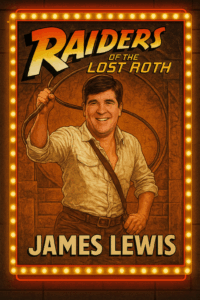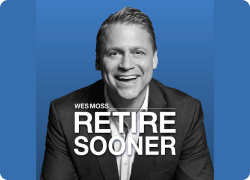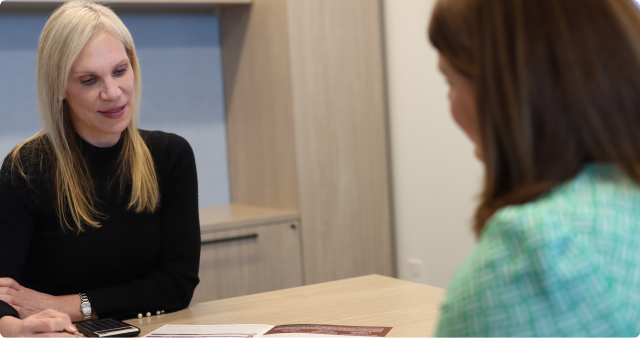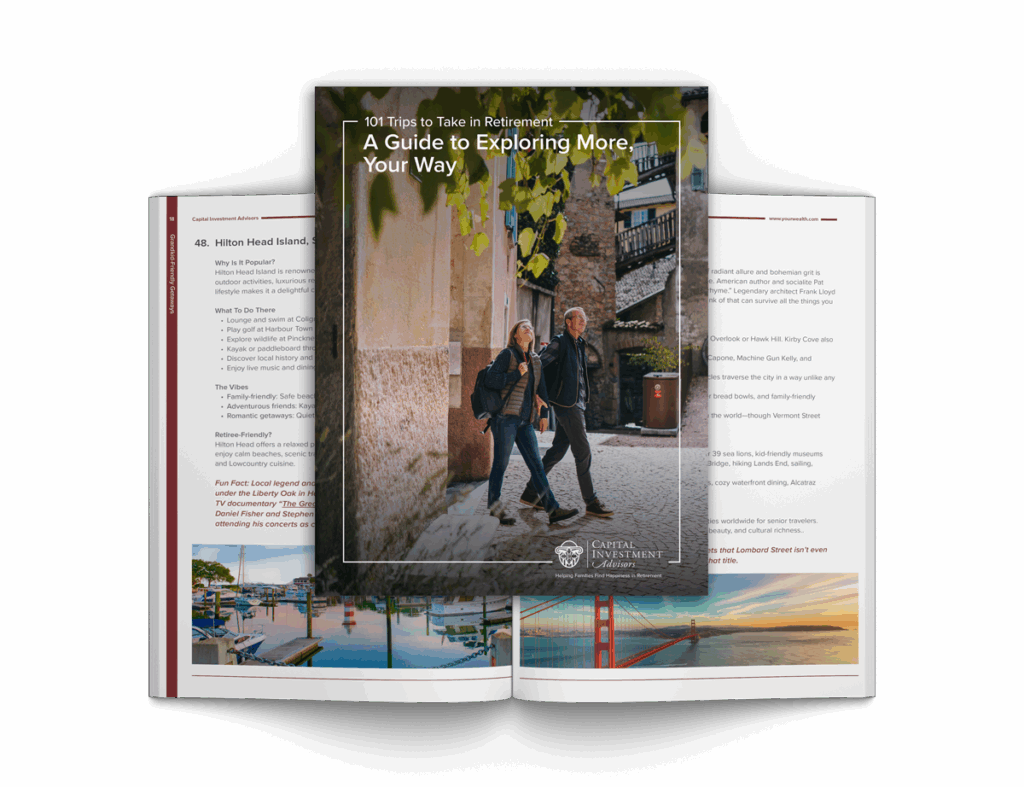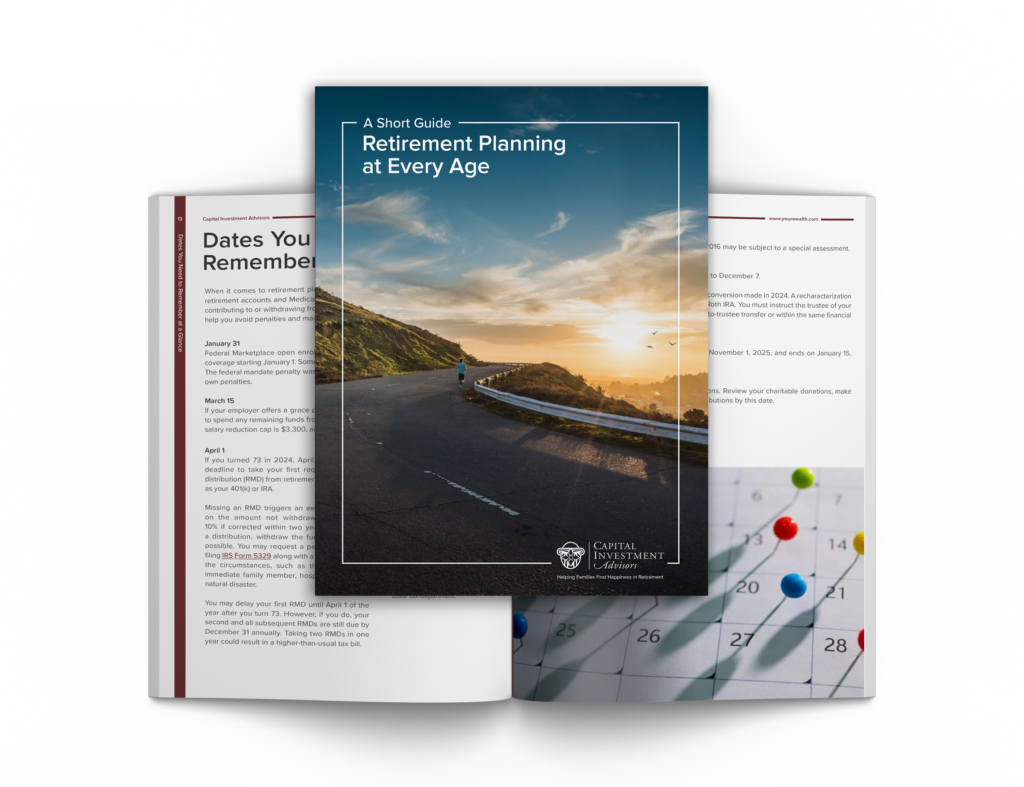Should you take a lump sum or pension payout? Use the 6% Test to help you decide. With markets hitting record highs, is it the right time to invest, or should you wait? History suggests some clues that retirement planning should not be left to chance. Wes Moss and Christa DiBiase provide crucial context by answering listener questions about 401(k) target date funds, beta vs. volatility, selling a business for retirement, mega backdoor Roth IRAs, and inherited IRAs.
Read The Full Transcript From This Episode
(click below to expand and read the full interview)
- Wes Moss [00:00:02]:
I’m Wes Moss. The prevailing thought in America is that you’ll never have enough money and it’s almost impossible to retire early. Actually, I think the opposite is true. For more than 20 years, I’ve been researching, studying and advising American families, including those who started late, on how to retire sooner and happier. Now I’m bringing in my good friend Krista Dibias, who has worked closely with Clark Howard for many years now to answer your questions and explore what makes a happy and fulfilling retirement. My mission on the Retire Sooner podcast is to help a million people retire earlier while enjoying the adventure along the way. I’d love for you to be one of them. Let’s get started.Wes Moss [00:00:48]:
Krista, hello.Krista Dibias [00:00:50]:
Hello, Wes. We are back this week and you’re gonna talk about something we get a lot of questions about on the Cork Howard show, but we rarely talk about and that is if you’re lucky enough to have a pension, which is, you know, pretty legacy at this point, but many people do.Wes Moss [00:01:04]:
Still a lot of people that have them.Krista Dibias [00:01:05]:
Still a lot of people that have them. And if you’re given the choice, take a lump sum or get the pension payout, what do you do and what else are you going to talk about later on today?Wes Moss [00:01:14]:
Well, the other thing is that so far in 2025, the markets have been strong again and they’re kind of bumping up and hitting new highs and it’s kind of nerve wracking to invest around that time. So I want to talk about some of the history there.Krista Dibias [00:01:27]:
I love it and I have lots of great questions for you today. We’ll get started.Wes Moss [00:01:31]:
Let’s start with pension. Lump sum. Yes. So there’s a couple of things. There’s companies don’t love to be in the news about this because nobody, no company likes to say how many people they’re laying off. But the reality is that in the multi million workforce that we have companies from time to time say, wait a minute, we’ve got a little too many employees and we’ve got pension obligations and people are living longer. So we’re going to say a couple years ago, 2019, GE announced and they were, this was a headline, they offered 100,000 people, they wanted to downsize by a hundred thousand people. So typically when that happens, those with a pension are going to have to make a decision, do they take a big chunk of money, a lump sum or take a lifetime payout either for their life and, or their spouse’s life instead of lump sum? So, so that’s a tricky situation.Wes Moss [00:02:25]:
I think that we’re going to hear a lot of this with the government employees this year. There’s been an offer to 2 million some government employees to resign or not work anymore. And a lot of those folks have pensions. I’ve heard from a lot of those people now they’re not going to probably have to make that decision until later in 2025, but there’s going to be a lot of that coming. So the question is, what’s a better deal? The big chunk of money or the monthly almost guaranteed pension for life? And I look at it first with the math. So I think the math is the first way to start. And very simply, you’re going to get up a couple pieces of paper and it’s going to say, here’s your, here’s your monthly amount that you can choose to take. And then there’s another amount, typically, and there’s usually five or six options.Wes Moss [00:03:16]:
Here is that you, here’s an amount that’ll be less per month that will cover you, your life and your spouse. It’s called a hundred percent joint survivor. So let’s say one is $10,000 a month. It’s just your life. You die in a year, it’s gone. Nobody gets anything else. I’ve almost never seen anybody take that. But once in a while, that’s the, that might be the right option.Wes Moss [00:03:36]:
More typically, what I will see is folks, they’ll take the one that covers their life plus someone else in case something happens to them. So it’s going to be a lower amount because the annuity company on the annuity tables have to cover two lives. So the longer the expected life, the lower the payout per month will be. So let’s start with that. Let’s say instead of the $10,000 single life per month, and these are big numbers, it’d be a great pension to have. It’s $8,000. So we take that number. You take your pension, monthly pension amount, you Multiply it by 12, you get your annual amount and.Wes Moss [00:04:10]:
And then you divide that number by the lump sum that you could otherwise take. And if the monthly pension amount is 6%, I call this the 6% test is 6% or more. Then you can start thinking, well, maybe I do take this monthly amount because it’s quote guaranteed. It is for the rest of my life, the rest of my spouse’s life, and I don’t have to worry about investing it. So there’s some real benefit to that. The if it is anything 6% or lower, then I think it’s Not a very good deal because they’re essentially giving you your own money back. And we, we think that over time, the way I look at this, not just from an investment perspective, but you can take your own money. You take 5% out for 20 years before you run out.Wes Moss [00:04:58]:
And that’s just without any sort of rate of return. So 100 divided by 5 is 20. So if you’re only getting 6%, that’s just the bare minimum they would quote, promise you before you would consider taking the monthly amount. Now, I’ve run a lot of pension numbers over the last couple of years and sometimes they’re 7 or 8%. And that really makes people think, well, that’s a pretty good rate of return. The other thing you have to think about is that’s a static number. Now some pensions, like for instance, the teacher pension, the trs, typically in most states, those pensions do increase for inflation. So that’s a consideration.Wes Moss [00:05:36]:
Most, if not everyone I’ve ever seen corporate pension is static. So it might be Your offer is $6,000 a month. Okay, that sounds pretty good. But it’s still going to be $6,000 a month in 10 years and in 20 years and in 30 years, if you live that long, it’ll still be $6,000 a month. So inflation will have reduced how powerful that money is. You’ve got to really take that into account. So there’s a lot of considerations. Do you have any other income streams? If you, do you have any other savings? Let’s say you don’t have a lot of liquid savings that would make someone lean towards taking the lump sum amount because the money is yours, you can typically just roll that into an ira and it’s got to be the right decision for you.Wes Moss [00:06:19]:
But that’s one of those decisions. If that works, works and you want to invest in an ira, you can take the lump sum and you can roll it into an ira. Again, if the, if the investment choices in your other plan maybe are not something that are working for you, you have the option to roll it in your own ira, invest it, and then just create your own pension. So that’s the way I would look at this. And let’s just run some quick math here. I’m going to make these numbers up. Krista, give me a, give me a monthly pension amount.Krista Dibias [00:06:48]:
$2500.Wes Moss [00:06:49]:
$2500. So let’s say you get 2500 bucks per month. Is the offer times 12 is $30,000 a year. Okay, well would you take $30,000 a year or would you Take a lump sum of $200,000. What would be a better deal?Krista Dibias [00:07:08]:
I would say taking the monthly pension would be a better deal in that.Wes Moss [00:07:12]:
It is for sure it is, because that’s 15%. $200,000 sounds like a lot, but if they’re going to promise you $30,000 a year, 30 divided by 200, it’s fit. You’re right. Way above the 6% number.Krista Dibias [00:07:25]:
Yeah.Wes Moss [00:07:26]:
Now, what if I give you a higher lump sum option? Okay, $30,000 a year, or let’s say $400,000 a year or $400,000 of lump sum.Krista Dibias [00:07:38]:
Okay. That’s tougher.Wes Moss [00:07:40]:
That’s tougher. That’s probably $30,000 a year for life or 400k.Krista Dibias [00:07:45]:
Probably 400k.Wes Moss [00:07:47]:
Okay. I would say the pension still is above the 6% test there. It’s pretty good, 7.5%. But for most pensions, I see, it makes it to be a tough choice. They’re usually, when you do the math, it’s usually between five, and then you say, oh, I probably want the lump sum. But then they’ll creep up to seven, seven and a half, like the example we just gave. And it makes it a little tougher. More often than not, I’ll see people say, I’d rather just have the money, the bird in hand.Wes Moss [00:08:16]:
I’ll invest it that way that if something happens to me, I know it goes to my spouse, I know it goes to my beneficiaries. But if you’ve already got a bunch of savings, one of the traits of the happy retiree, they have three or more income streams. So let’s say you only have Social Security 1 and Social Security 2 for you and your spouse, and that’s it. At that point, if you have a decent pension offer, if it’s seven and a half percent, you at least would consider taking the pension, the monthly pension amount, because it helps with your income streams and you’ve got some other money saved. So there’s a lot to think about. But when it comes to taking a lump sum versus a pension, start with the 6% test.Krista Dibias [00:08:58]:
Okay, we’re going to go to some questions now. This one came in from Bruce in North Carolina. I have my 401k invested in Vanguard Target Retirement Fund 2025, but I will continue to work until March of 26. I’ll be 67 years at that time. Should I move my money to the 2030 Target Fund or leave it alone?Wes Moss [00:09:16]:
Hmm. The target. This question for Bruce, the short answer is you got to get your allocation right and a target Date fund is just a shortcut to do that. I think. We think these target date funds are kind of some automatic magical as. As if they know you and they know your retirement. Just because you tell you say I’m going to retire in 2030, that means I need the 2030 fund. That’s not correct.Wes Moss [00:09:43]:
It’s a good way to look at it, but it’s not necessarily a great way to look at it because first of all, target date funds are not all created equal, meaning some have a ton of international, some get more conservative more quickly. The way I see this is that most target date funds get to the point where about 50% of the fund is in in bonds by the time you get to your retirement year. So the 2030 fund, you say I’m going to retire in 2030. Typically that target date fund, and they’re almost every mutual fund family has a target date, has a bunch of target date options. I think they get overly conservative, overly quickly. Imagine if you retire and you’re 58, that’d be great.Krista Dibias [00:10:28]:
Yeah.Wes Moss [00:10:29]:
And you’ve picked this target date fund that matches your the year you retire and now you’re at 50% in bonds right out of the gate. And then it gets even more conservative for the rest of your life. So by the time you’re 70, you might have 70% of bonds. So I love the allocation that target date funds give people because they automatically balance you between US Stocks, international stocks and a couple different types of safety, which I love. But they typically get really, I would say the percentage gets really high in conservative investments almost too soon, particularly the world we live in where God willing, we’re in retirement for 20 or 30 or maybe even more years. So Bruce, it’s not about the target date fund and what it does. It’s about what allocation is right for you. And if you want to have 60% in stocks and only 40% bonds, then either find the target date fund that is in that posture or just use the funds of that fund family to create your own balance.Wes Moss [00:11:33]:
And then you can choose when to make it more conservative or more aggressive whenever you want to.Krista Dibias [00:11:38]:
Bruce Great Ron in North Carolina wrote in with this Wes. When analyzing stocks and ETFs, one important financial metric is its beta. However, this term seems to be a misnomer as it seems to be used synonymously with the term volatility. Also, when checking the beta values across various financial websites, each site has often assigned a very different beta value to a given stock. Can you please clarify the meaning of the terms Beta and volatility and provide guidance on where to get an accurate beta value.Wes Moss [00:12:09]:
Wow. Good luck, Ron. Because they’re different everywhere. So a couple of distinctions here. Volatility just means how much any given asset class is has a propensity to move up or down. Beta similar and this is why I get the Bruce is a little confused on that. But beta is your is volatility relative to something else. A beta for a stock usually is measured against the S&P 500.Wes Moss [00:12:39]:
So if the S and P beta, let’s say is 1 and a stock is 0.5 of a beta, that means in any given movement over the course of, let’s say a year, the stock market’s up 20% that that stock with half the beta may only be up half. If the stock market’s down 20%, maybe that stock’s only down half of that, only down 10. Same thing in reverse. A beta of one and a half will have 50% more volatility relative to, in this case the S&P 500. What makes it hard to standardize and find a beta and why they’re different on every site is that very often it’s for different periods of time. Well, what’s a beta over a year? What’s the beta for the stock over a three year period, over a five year period? And different websites will use different time frames to assign where the beta is relative to. And that’s why it’s going to be hard to find an exact beta from site to site to site. I think it is a really good way to look at it because we do a lot of investors, not every investor, like a little less volatility than the overall market.Wes Moss [00:13:44]:
So whether it’s a one year or a three year beta that is underneath or below the S&P 500s beta, I think that’s a smart thing to look for. The other thing again, on top of that, more icing of why the beta can be this beta conversation can be a little confusing is that it doesn’t have to be relative to the S&P 500. The beta of a stock can be relative to the Russell 3000 or the NASDAQ. So it’s a volatility term, but it’s a relative volatility term. Ron. Hope that helps.Krista Dibias [00:14:16]:
Great. This question came in for you from McKay in Colorado. I’ve been helping family prepare for retirement by motivating them to save more. I have one family member however, who is going to sell their business and that’s going to be a big chunk of Money that fuels their retirement. What do we need to consider the situation? Is there somebody we should be consulting to structure this best for tax purposes? And how should I be allocating their current Savings to their 401k knowing that this huge chunk of money is on the horizon and could be used for the cash bucket or the bond bucket?Wes Moss [00:14:48]:
Oh, sounds like McKay is the family advisor now. McKay, you may not want to hear this, but I’m going to. The short answer on this one is lawyer. Lawyer, estate planner, cpa, then financial advisor.Krista Dibias [00:15:04]:
Okay.Wes Moss [00:15:05]:
And I’ve been through a lot of these for families I’ve worked with over the years where they’re selling a business. And I’ve been through this myself as well. Selling a business, you’re thinking, well, I’m going to sell the business and then I’ve got all this money and I’ve got to invest it. And that’s what you’re focused on mentally. Well, how am I going to invest the money? Wait a minute. Okay, there’s so much that goes into it before you get the money is you got to figure out the terms of the deal. So you need a good deal attorney. And if million dollar business sale, well, you need a deal attorney.Wes Moss [00:15:35]:
5 million, 10 million, 20 million. So anytime you’re selling a business, it’s usually a pretty big number. So you need a deal attorney to make sure the terms of the deal are right. The second thing would be an estate planning attorney. Where are these assets going to go? Are they going to go into a trust? They’re going to go into someone’s personal name? Those are all huge considerations because that also can impact the taxes. Now you need a cpa. So your CPA should be planned. You should be planning what this sale looks like.Wes Moss [00:16:03]:
Is it over time, Is it one lump sum? Is it capital, long term capital gain, Is it ordinary income? You’re going to be able to plan for that because if you don’t know how much there will be in taxes, then you really don’t know how much you’re going to be investing after the taxes are paid and then when the taxes are due. So as much as nobody likes paying lawyers in a big transaction, this is where I’ve seen them really come in handy. So deal attorney, state planning attorney, cpa. And then you can go to a cfp and maybe the CFP or a financial advisor is quarterbacking all that to begin with, and maybe that advisor is McKay. But that’s the kind of the way I would look at this is all these disciplines really matter, right? Now, when you’re selling a business and then you can figure out what the best way to invest it over time.Krista Dibias [00:16:50]:
Okay. And maybe for that you said financial planner. And coming up next, you’re going to talk about how to invest when the stock market is around all time highs.Wes Moss [00:16:59]:
What do you do when the market’s already high? If you’ve ever done a Jane Fonda workout or if you remember as a kid, Rocky running the steps. And if Michael keaton is still Mr. Mom to you, the then guess what? It’s officially time to do some retirement planning. It’s Wes Moss from Money Matters. Weren’t those the good old days? Well, with a little bit of retirement planning, there are plenty of good days ahead. Schedule an appointment with our team today@yourwealth.com that’s y o u r your wealth dot com. Do we have more questions? Yes, we sure we do.Krista Dibias [00:17:38]:
Oh, we do. We have lots of questions.Wes Moss [00:17:40]:
How do you pick the questions? I just flex.Krista Dibias [00:17:45]:
I don’t want to give away all my secrets. No, I just, I honestly just usually choose the ones that come in for you. And we try to have a variety. So if you’ve already answered it, you know, we don’t want to answer that again the next week.Wes Moss [00:17:57]:
Okay. I’m always surprised that the one thing that’s cool about this is that even though we all are kind of trying to get to the same spot, I want enough money to never run out so I can stop working. That’s kind of traditional retirement. There’s a lot more to it. I’ve written books about happy versus unhappy retirement, but from a money perspective, there’s. There’s so many variables. Let’s call them. Let’s say there’s 20 variables that we all have to deal with 20 times and maybe it’s 20 squared or, or more than squared.Wes Moss [00:18:28]:
Makes it almost infinite number of questions that we will get because everybody is that unique.Krista Dibias [00:18:34]:
It’s so true. And I will say this. If the questions go on for pages, we’re not going to be able to answer those on the show if they’re too complex. It’s too much. You probably should.Wes Moss [00:18:44]:
I like the long ones.Krista Dibias [00:18:45]:
Well, you know, it just depends. But it can’t take me 20 minutes to read a question. We can’t do that.Wes Moss [00:18:50]:
All right, let’s go. Let’s see what we can do. Well, we’re going to talk about the market for a minute.Krista Dibias [00:18:54]:
Here we are.Wes Moss [00:18:55]:
I think we all struggle with this. When we’re bought, we’re bought. We’re Born and we’re taught that’s how I got bought. We were born and we hear forever. We buy low and we sell high.Krista Dibias [00:19:08]:
Ideally.Wes Moss [00:19:09]:
Ideally, that’s what we want to do. I think what makes investing really difficult sometimes is that we go in these longer stretches when the market’s doing pretty well and you’ve got the market 2024. I remember the beginning of the year we hit an all time high and everyone’s scared. Well, I don’t want to put money to work when I’m at an all time market high. So we went back and looked at history and have been doing this now for, for a long time. And talking about these statistics, we tend to get more all time highs than people really give credit to because they don’t really make the news. So the s and P500 can go up a half a point and it can be an all time high. So it doesn’t get a lot of fanfare.Wes Moss [00:19:50]:
So they happen way more often than we think. There’s something like in the last, since 1950, there are over 1,250 new market highs. There were 57 new market highs in 2024. So at the beginning of the year we hit an all time high. And you said, well, I’m going to wait, I’ve got cash, I want to invest it, but I’m not going to invest it because we’re at an all time high. Guess what? You missed out on a 25% rate of return. So last year is emblematic of actually what happens over the course of history. All time market highs tend to come in big clumps.Wes Moss [00:20:27]:
We’ll get 20 of them in a year, 30, 40 last year, 57 all time highs. Then we’ll go into years that are in bear markets and we’ll go a year or two or maybe more without any all time highs. So they tend to come in clumps. So first of all, they’re not that rare. Second of all, if you go back over the course of history and I pulled some numbers from 1970 until through last year, if you were to choose to only invest money once the market hit an all time high, the average rate of return over the next year is actually higher than just investing in any other random day. That was a study by J.P. morgan. There’s another study that looks at 1988 through 2020 and it shows that investing at an all time high was even greater.Wes Moss [00:21:14]:
So picking the hey with the market in an all time high, well, 14.5% average rate of return a year later versus any random data is more like 11. So I go through this data and I think, well, why is the market even better once it’s already hit a high? I think a big part of it is a lot of things have to be going right to get to an all time high. So you’ve got to have a pretty good economy, you’ve got to have inflation relatively in check, you’ve got to have a pretty decent outlook for the economy and for corporate earnings in order for the market to get to the point where it has an all time high. And I think there’s a little bit of this, what I would think of a flywheel effect. Once you get some momentum going, it’s a little harder to stop the momentum. And this is in a positive way. So the numbers support that once the market hits an all time high, there’s a high propensity that continues to have more all time highs. And the frequency of corrections, so negative 10% rates are returned once you hit an all time high is actually lower over the course of economic and stock market history.Wes Moss [00:22:24]:
It’s a lower probability than when the market is not in an all time high, which is also interesting. So I think that it’s almost as if once the market is doing well, it tends to continue to do well for a little while. Now it doesn’t mean we don’t go back into corrections. We hit a recession, we market corrects down 10%. Sure, bear market down 20%. But the other really big part of this is that bull markets last a lot longer than bear markets. So bull markets tend on average to last or the median length of a bull market is something like 46 months. That’s a long time.Wes Moss [00:22:59]:
That’s for over, let’s call it four plus years. And the average bear market is more like five years. So median four, average five. The average bear market is much shorter than that. It’s one quarter of the length on average over the course of history. So that’s the other reason why we tend to you. You don’t necessarily want to try to wait, wait, wait, wait, wait to put money to the work just because the market’s done well to wait for a bear market because you can miss out on huge, huge gains that you’ll never be able to recoup just because you got to the point where high. I bought when the market was down 20%.Wes Moss [00:23:34]:
So it goes a little bit against our natural instinct. We want to buy when market’s already down. The other thing, when it comes to markets being down, most people don’t want to buy when markets are down 20%. True.Krista Dibias [00:23:45]:
But you’re buying at a discount.Wes Moss [00:23:46]:
You’re buying at a discount. But there’s even more fear sometimes the markets are not doing well. So it’s really about and how do I sum all this up? Investing is about participation. It’s not about perfection.Krista Dibias [00:23:59]:
Would you say dollar cost averaging is the key?Wes Moss [00:24:02]:
Dollar cost averaging is a. Is a wonderful Robitusset elixir for this problem of I’m not, I’m, I’m not, I’m not comfortable putting money to work. I’ve got some cash. If you’re not comfortable putting to work, figure out a way to just dollar cost average it in over the course of six months. I think that’s a, that’s another way to kind of fight this mental block that a lot of investors have.Krista Dibias [00:24:26]:
Awesome. We’ll go to questions. Stanley in Iowa wrote in with this one for you. Wes. I currently make roth contributions to 401k up to the max and also contribute a significant amount into a joint brokerage with my wife for liquidity. However, I was recently educated that a better option is to make a mega backdoor Roth contributions periodically roll over the funds to my Roth IRA so I can withdraw the contributions as needed. It seems like a cheat code since withdrawing contributions is not a taxable event. But after some quick research, it seems there are some caveats to doing this.Krista Dibias [00:25:00]:
That is Additional tax forms, the spouse has no assets, et cetera. Is that really a better route or should we continue putting money into the brokerage account?Wes Moss [00:25:10]:
The. The short answer is it’s, it’s, it’s not a cheat code. It’s a real thing. It’s the and, and you, if you go online and look this up, you’re going to find 20 different articles about it from lots of different financial institutions. The so it’s a very real thing. The reason and if you can do it, it’s, it is something to consider. However. However, there’s always a but or however.Wes Moss [00:25:35]:
It’s a. It’s pretty complicated because one your retirement plan has to allow for it. Not all retirement plans allow you to put money in and then do an in service withdrawal that same year. So it’s something that your plan has to to allow for. What Stanley from Iowa is talking about here is that most of us, if we have a 401k, we’ve got our, our limit of $23,000 a year. Some plans will allow you to contribute more than that, but those are now after tax dollars. So again, you’ve got to have a plan that allows for that too. So instead of $23,000, you put in your $23,000 and another $20,000.Wes Moss [00:26:11]:
And I believe the limit’s something like $70,000 with after tax contributions. So Stanley puts in his $23,000, puts in another $20,000, and then he can convert that into a Roth. And this plan has to allow for it. That’s a way to get a ton of money into a Roth. Now where it gets more complicated is if that money grows. So you put that money in your $43,000, now $53,000. The contributions should not be taxed to get them into a Roth, but the, the gain is. So now you have to worry about the gain.Wes Moss [00:26:45]:
You have to file special forms. You’re putting money into a Roth, which is just in your name. Whereas a brokerage as an example, is an account where it can be a joint account. There’s a little more flexibility about that. The other thing to consider is that, yes, the Roth is great because it grows tax deferred. It comes out tax free. However, when you’re in retirement, if you’ve managed your tax bracket to be pretty, let’s call it in the 15% tax bracket, which a lot of Americans are. Just remember that dividends and long term capital gain rates can be zero.Wes Moss [00:27:23]:
So we can access our money depending on your tax bracket. If it’s got to be 15% or lower, the long term capital gain rate and the dividend tax rate is zero. So you don’t have to get money into a Roth. But if you’re going to be in a higher tax bracket into retirement in the future, then sure, it’s a great idea. So I would just know the complexities of this, Stanley. You’ve got to consult with an advisor to do this, I think. But if your plan allows for it and you want to do this every single year and make sure you’re filling out the proper forms every single year, by all means.Krista Dibias [00:27:56]:
All right. Charlotte in Arizona says, I recently lost my parents seven months apart. So sorry to hear about that, Charlotte. Which led me to inheriting some money from their estate. I inherited Both a traditional IRA and a Roth IRA. I know I need to exhaust both within 10 years. My plan is to let the Roth IRA sit for 10 years and grow. As I’ve been told, I don’t need to make RMDs.Krista Dibias [00:28:18]:
My plan for the traditional is to take only the minimum RMD until I have a year where my income is lower. Maybe even by design, like A sabbatical and then take the bulk of it out then. Is this a good strategy? Is there a better way to withdraw? With regards to the taxes, The Roth is 38k and the traditional IRA is 160k. I have to start my RMDs by this December of 2025. Any input for a different strategy is appreciated.Wes Moss [00:28:44]:
I love the sabbatical idea. So, Charlotte from Arizona, this is also about managing your tax rate. So we’ve a lot of finance and investing is around understanding what your tax rate is today and then what your tax rate may be in the future. And she’s got. I’ve seen this has worked out really well for some folks. Let’s say Charlotte knows that she’s. Some companies allow six months off. Now, granted, usually you’re still getting paid for that.Wes Moss [00:29:14]:
Those are sabbaticals. But if you’re Charlotte taking six months off and you know you’re going to do it or a whole year and that’s still okay with your big picture retirement plan, you know your income is going to be virtually zero except for some of these required minimum distributions. So you end up, let’s say Charlotte’s income falls all the way down to $10,000 a year. Well, she’s got a lot of room while she’s still in a really low tax bracket to do some of these RMDs or more than the required minimum distribution. So a, I would. Yes, I like the strategy what she’s considering. You don’t need to take out anything from the roth until the 10th year. So let that thing grow and then if God willing, it doubles, triples.Wes Moss [00:30:02]:
It’s still tax free. So you’re great. So let the inherited Roth go the full 10 years. Once you distribute it, it’s still tax free on the traditional IRA, the $160,000. A, she can wait and take a bigger chunk out during the sabbatical year. But again, that quickly fills up her tax bracket. Remember we talked about different the lock system in Denmark. The boat has to go from here to here.Wes Moss [00:30:29]:
And in each point you’ve got to fill up the new chamber of water. That’s your tax bracket. New chamber of water, that’s your tax bracket. So Charlotte, if you know you’re going to do a sabbatical, great year to do more distribution from the regular ira. If you don’t know and you think you are going to end up continuing to work, then you don’t want to be stuck with taking the 160, which could be 260 in 10 years. Out all at once. So I would spread out knowing that you’re probably going to have to take out more than 160, more like 200 over 10 years because it should grow. So you’re going to be looking at probably averaging around $20,000 a year to make sure it’s done by the 10th year so that you don’t get a giant amount all in that same year.Wes Moss [00:31:11]:
That pushes you into the 35 tax bracket.Krista Dibias [00:31:14]:
Perfect. Eric in Georgia says Wes, I actually have a very small pension account from a former employer whom I work with long enough to be vested in their plan before they moved completely to a defined contributions program. The current value is about $30,000. It’s managed by a big benefits management company who includes tools to calculate out what the pension fund will be worth depending on when you actually take it. That calculator shows if I take it as an annuity at age 65, it will be around $350 a month for the rest of my life. The problem is the calculator assumes a 6% growth on the balance, but the actual accrual is a formula is based on annual interest rates, the one year treasury constant maturities plus percent. Yeah, prior to about 2006, that did amount to closer to 6%, but going forward, it really hasn’t come up past maybe 3% in the last almost 20 years. Going forward, I’m not confident in that 6% calculator rate.Krista Dibias [00:32:10]:
And changing that assumption to 2%, which is closer to the actual average, shows an annuity of $180 a month. I was wondering if it made more sense to take the pension payout now $30,000, roll it into my IRA and let it grow there instead of as a pension. My IRAs performed spectacularly over the last few years. And even assuming a reversion to a return closer to 6% annually over the next 10 years, I think I’m better off taking the risk. So this goes back to what you talked about at the beginning of the show.Wes Moss [00:32:38]:
Yeah, but there’s another wrinkle here is that there is. He is. He also is looking at what the lump sum is today, what it could be well into the future. And like a lot of pension plans, Eric, they’re going to be invested super conservatively. So if it’s the one year treasury, which is essentially what sounds like, that’s the rate, that is not going to be 6% anytime soon. And we’d have to have a lot of inflation. The Fed would have to raise rates a whole bunch today. That’s closer to 4%.Wes Moss [00:33:17]:
Right. It’s closer to where the federal funds rate is. And if the Fed lowers rates it could be in the threes. And that’s probably why he’s noticed that it hasn’t grown a whole lot. It’s basically a fixed income investment. So that’s a consideration is that it’s going to be a really conservative rate of return. Now I would look at these numbers. We do the 6% test.Wes Moss [00:33:36]:
Even if it’s 180amonth, 180 times 1220, 100 bucks here, 2160 year divided by 37.2% still beats 6% test. If it is in fact 350amonth times 1240, 200 bucks a year divided by 30,000. That’s a 14% annual rate of return on the pension. So it makes the monthly amount a really good deal. I just don’t know if it’s going to get there. So I would consider the. It’s this is a little bit less about the 6% test because he’s not there yet and more about how you would like to invest it. And again, I don’t know if he gave us his age, but if this is 10 years from now, if it’s still going to be stuck at the one year treasury rate, it shouldn’t really grow all that much.Wes Moss [00:34:27]:
So if you’re comfortable doing so and you want to take it under your control and invest it and looking for a more market stock oriented rate of return or even a balanced portfolio, 6 to 10% then I think that weighs on this decision. More to do then Eric, if you’re looking for more like a 6% to 10% rate of return, it likely has to involve some other assets like equities, real estate, REITs, et cetera. And if that’s the case, then you would really want to consider putting that in your own retirement account and investing it so that you can get a better rate of return. The 6% test here doesn’t really stand because it’s so far out in the future. We don’t know exactly what those numbers are going to be. Krista Dibias, thank you. You can send us More questions@yourwealth.com contact. Have a wonderful rest of your day.Mallory [00:35:23]:
Hey y’all, this is Mallory with the Retire Sooner team. Please be sure to rate and subscribe to this podcast and share it with a friend. If you have any questions you can find us@wesmoss.com that’s w e s m o s s dot com. You can also follow us on Instagram and YouTube. You’ll find us under the handle Retire Sooner podcast. And now for our show’s disclosure this is provided as a resource for informational purposes and is not to be viewed as investment advice or recommendations. This information is being presented without consideration of the investment objectives, risk tolerance, or financial circumstances of any specific investor and might not be suitable for all investors. The mention of any company is provided to you for informational purposes and as an example only, and is not to be considered investment advice or recommendation or an endorsement of any particular company.Mallory [00:36:10]:
Past performance is not indicative of future results. Investing involves risk, including possible loss of principal. There is no guarantee offered that investment return, yield or performance will be achieved. The information provided is strictly an opinion and for informational purposes only, and it is not known whether the strategies will be successful. There are many aspects and criteria that must be examined and considered before investing. This information is not intended to and should not form a primary basis for any investment decision that you may make. Always consult your own legal tax or investment advisor before making any investment, tax, estate or financial planning considerations or decisions. Investment decisions should not be made solely based on information contained herein.
Call in with your financial questions for our team to answer: 800-805-6301
Join other happy retirees on our Retire Sooner Facebook Group: https://www.facebook.com/groups/retiresoonerpodcast
This information is provided to you as a resource for educational purposes and as an example only and is not to be considered investment advice or recommendation or an endorsement of any particular security. Investing involves risk, including the possible loss of principal. There is no guarantee offered that investment return, yield, or performance will be achieved. There will be periods of performance fluctuations, including periods of negative returns and periods where dividends will not be paid. Past performance is not indicative of future results when considering any investment vehicle. The mention of any specific security should not be inferred as having been successful or responsible for any investor achieving their investment goals. Additionally, the mention of any specific security is not to infer investment success of the security or of any portfolio. A reader may request a list of all recommendations made by Capital Investment Advisors within the immediately preceding period of one year upon written request to Capital Investment Advisors. It is not known whether any investor holding the mentioned securities have achieved their investment goals or experienced appreciation of their portfolio. This information is being presented without consideration of the investment objectives, risk tolerance, or financial circumstances of any specific investor and might not be suitable for all investors. This information is not intended to, and should not, form a primary basis for any investment decision that you may make. Always consult your own legal, tax, or investment advisor before making any investment/tax/estate/financial planning considerations or decisions.


